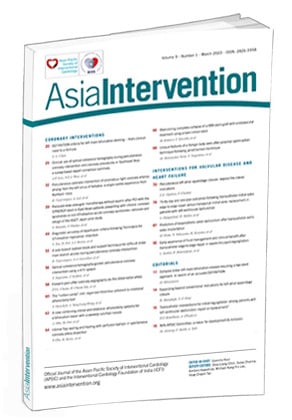Patients with atrial fibrillation (AF) are well known to have an increased risk of ischaemic stroke, which can cause significant morbidity and mortality1. For decades, oral anticoagulant (OAC) therapy using vitamin K antagonists (VKAs), such as warfarin, has been the mainstay for the prevention of stroke in patients with AF. More recently, direct oral anticoagulants (DOACs) have increasingly been used and recommended as alternatives to warfarin for stroke prevention in non-valvular AF2. Since more than 90% of embolic strokes are caused by thrombi from the left atrial appendage (LAA)3, novel preventative strategies for the mechanical closure of the LAA have been extensively investigated. Percutaneous LAA closure (LAAC) using the WATCHMAN device (Boston Scientific) has been studied in several randomised trials45 and registries67. The PROTECT AF trial (WATCHMAN Left Atrial Appendage System for Embolic PROTECTion in Patients with Atrial Fibrillation) showed non-inferiority and superiority compared to warfarin in stroke, systemic embolism and cardiovascular mortality4. The PREVAIL trial (Prospective Randomized Evaluation of the WATCHMAN LAA Closure Device in Patients With Atrial Fibrillation Versus Long Term Warfarin Therapy) showed non-inferiority for post-procedural ischaemic stroke5. The Continued Access to PROTECT-AF (CAP) registry and the Continued Access to PREVAIL (CAP2) registry supported the long-term safety and efficacy of LAAC for long-term anticoagulation in patients with non-valvular AF6.
Despite these studies being performed among patients that are candidates for long-term OAC, the WATCHMAN device and its newer version, WATCHMAN FLX (Boston Scientific), are approved by the U.S. Food and Drug Administration for patients who have an appropriate reason to seek a non-pharmacological alternative to OAC therapy8. Furthermore, both the 2019 American Heart Association/American College of Cardiology/Heart Rhythm Society and the 2020 European Society of Cardiology Guidelines reported that percutaneous LAAC can be considered in patients with AF at high risk of stroke who have a contraindication for long-term anticoagulation (class of recommendation IIb; level of evidence B)29. However, it remains unclear which patients with AF are contraindicated for long-term anticoagulation.
In the real world, there seems to be more scope for the utilisation of LAAC. Vrana et al did a post hoc analysis of the MISOAC-AF (Motivational Interviewing to Support AntiCoagulation Adherence in Patients With Non-valvular Atrial Fibrillation) trial, which showed that one out of six patients who were hospitalised with non-valvular AF were eligible for percutaneous LAA occlusion (LAAO) for stroke prevention, due to a prior major bleeding event or treatment failure during OAC causing an embolic stroke10. An analysis from the National Cardiovascular Data Registry Left Atrial Appendage Occlusion (NCDR LAAO) Registry showed that real-world indications of LAAC were different from those in previous pivotal trials11. Therefore, it is necessary to further investigate which patients need an alternative therapy and/or which patients are contraindicated to OAC.
In this issue of EuroIntervention, Guérios et al review potential candidates for LAAC who are not classically indicated12. This review expands our knowledge about the types of disease conditions that should be considered a contraindication for long-term anticoagulation. Cerebral amyloid angiopathy, age-related macular degeneration, hereditary haemorrhagic telangiectasia, and moyamoya disease are all noted examples that have not classically been considered a contraindication to anticoagulation but would need to be considered; however, there is a difficulty with the large trials required to prove this assertion. This review also emphasises the potential patients who should get LAAC as an alternative to OAC. Patients who undergo LAA electric isolation would benefit from LAAC as an alternative to anticoagulation, since they have an increased risk of thrombus formation. Patients with persistent thrombi in the LAA after anticoagulation can be regarded as having had treatment failure and LAAC should be considered as a salvage treatment. Patients with end-stage renal disease have not been well studied with OAC in pivotal trials. These patients should be considered as a potential target for an alternative therapy with LAAC. This article also emphasises that patients with issues concerning medication adherence may also be good candidates for LAAC, as they need an alternative therapy that is safer and not affected by medication non-adherence. The authors conclude that there are many important clinical situations where LAAC is appropriate beyond the classic LAAC indications from the standard guidelines.
This review is of great interest because it highlights the gap between real-life usage of LAAC and the guideline recommendations. Being that it would be unethical to perform a randomised study in patients who are contraindicated to anticoagulation to compare the benefit of LAAC with OAC, it is important to interpret the current recommendations wisely. This article emphasises the need of a consensus definition of absolute or relative contraindications to OAC and represents several atypical conditions that would benefit from having alternative therapy options. Future studies which include a broader population of patients with non-valvular AF may help to expand the usage of LAAC beyond the current guidelines' narrow recommendations.
Conflict of interest statement
The authors have no conflicts of interest to declare.

